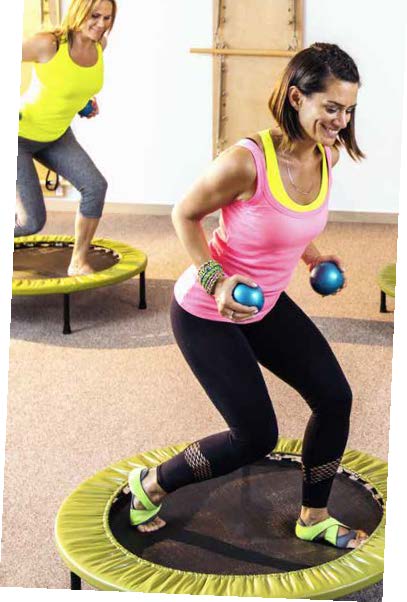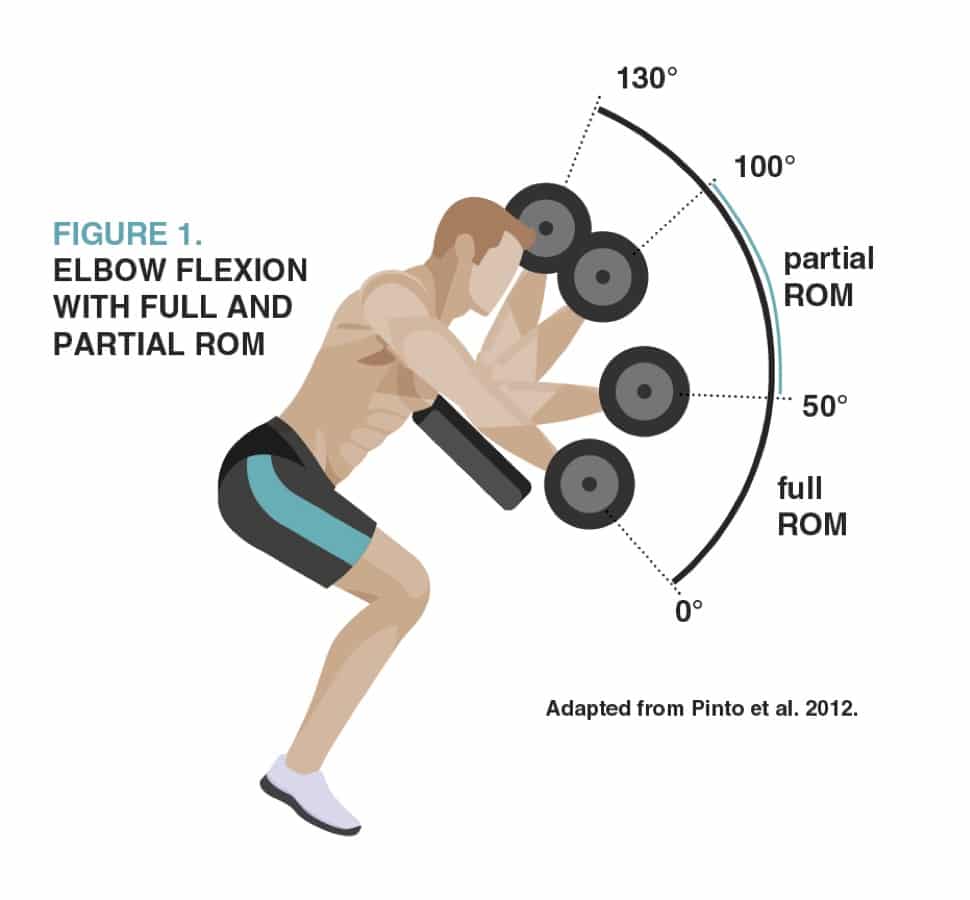Range of Motion: Full or Partial?
Studies on young adults find advantages in performing both kinds of resistance training movements.

Research shows there’s a time and place for both full and partial range of motion in resistance training program design.
Some training systems purposely use partial ROM for various exercises. Moreover, certain surgeries and orthopedic injuries require partial-ROM movements during rehabilitation (Pinto et al. 2012). It seems natural for personal trainers to wonder which is superior: full ROM or partial ROM?
Two studies comparing the benefits of partial ROM and full ROM give a clearer view of the landscape.
Study 1: ROM in Young Men
Pinto, R.S., et al. 2012. Effect of range of motion on muscle strength and thickness. Journal of Strength and Conditioning Research, 26 (8), 2140–45.
Purpose. Comparing the impact of partial-ROM versus full-ROM upper-body resistance training on strength and muscle thickness in untrained men.
Volunteers. A group of 40 young men with no resistance training experience or clinical problems was randomly divided into full-ROM and partial-ROM groups (15 each; average age 21.7) and a control group (10, average age 24.5) for a 10-week experiment.
Before and after strength test. The study tested maximal-strength elbow flexion using a full-ROM biceps curl on a preacher curl device, with standardized procedures to determine 1-RM.
Before and after muscle-thickness test. Researchers measured the thickness of right elbow flexors with an ultrasound technique that is noninvasive, reliable and safe.
Training. The full- and partial-ROM groups engaged in supervised training twice a week for 10 weeks, with a minimum of 48 hours between sessions. Using linear periodized training, the men began with 2 sets of 20 repetitions (weeks 1 and 2) and progressed to 4 sets of 8 repetitions (weeks 9 and 10).
Using the preacher curl exercise device, the full-ROM group did elbow flexion from 0–130 degrees, while the partial-ROM group did the flexion curl at 50–100 degrees—the mid range of motion for a biceps curl (see Figure 1).
The control group did no muscular fitness training. Other than the biceps flexor exercises, the full- and partial-ROM groups avoided formalized muscular fitness routines during the study.
Results. In 1-RM strength, the full-ROM group improved 25.7%, the partial-ROM group rose 16%, and the control group inched up 1.7%. Muscle thickness improved 9.5% and 7.3% for the full- and partial-ROM groups, respectively. The control group lost 2.4% of muscle thickness.
Take-home message: For strength, full ROM outperformed partial ROM in this muscle group (elbow flexors) and sample population (untrained men). However, the partial-ROM group did well enough to suggest that it’s a worthwhile training option.
Study 2: ROM in Young Women
Massey, C.D., et al. 2005. Influence of range of motion in resistance training in women: Early phase adaptations. Journal of Strength and Conditioning Research, 19 (2), 409–11.
Purpose. Comparing partial ROM versus full ROM for developing maximal upper-body strength in women.
Volunteers. Researchers randomly assigned 29 college-aged women to three groups: full ROM (13 women), partial ROM (eight women) and mixed ROM (eight women) for a 10-week study. The study described participants as occasional lifters with limited resistance training experience.
Before and after strength test. The study used a full-ROM 1-RM bench press as the principal measurement.
Training. In the twice-a-week study, the full-ROM group completed 3 bench press sets, the partial-ROM group trained with 3 sets at 2–5 inches from full elbow extension, and the mixed-ROM group combined partial- and full-ROM sets.
To match training loads, the mixed-ROM group completed 2 partial-ROM sets and 1 full-ROM set for the first 5 weeks, and then completed 1 partial-ROM set and 2 full-ROM sets for the last 5 weeks. All bench-training protocols used 15 repetitions, with loads progressively increasing in 5-pound increments as the volunteers’ muscular fitness improved. Initially, the full-ROM group trained at 65% of the participants’ 1-RM, while the partial-ROM group trained at 100% of 1-RM.
The authors cited previous research showing that the upper portion of the bench press lift is the strongest ROM. Therefore, that higher percentage of 1-RM for the partial-ROM group was deemed appropriate for this study. Also, on training days all volunteers completed 3 sets of the following exercises: squat (10 reps), upright row (15 reps), standing biceps curl (10 reps), latissimus dorsi pulldown (10 reps), crunches (15 reps), leg curls (12 reps) and calf heel raises (12 reps).
Results. As depicted in Table 1, the full-ROM training group improved significantly more than the partial-ROM and quasi-control (mixed) groups. However, each training group demonstrated a meaningful increase in 1-RM bench press.
Take-home message: All three training groups showed impressive increases in muscular strength in this group of untrained college-aged women. While the full-ROM group showed the best 1-RM bench press results, the partial-ROM and mixed-training groups also enjoyed notable increases in 1-RM strength. Thus, including both full- and partial-ROM moves looks like a suitable option in resistance training programs.
Mixed and Full ROM: Effective and Sporting
Both studies support the fitness industry practice of using both full- and partial-ROM resistance exercises. Though full-ROM exercises produced the biggest gains, partial-ROM movements fared well enough to suggest that trainers and coaches should keep using them.
Furthermore, Massey and colleagues note that well-known resistance training professionals recommend including partial-ROM training for some sports. After all, many sports movements, such as soccer kicks and baseball throws, are partial-ROM movements.
Note that both of the reviewed studies suggest that the best results from partial-ROM training (versus full-ROM) are achieved when trainers target the strongest part of a lift.
Pinto et al. suggest that fitness professionals and strength training coaches use full-ROM movements in the early phases of a person’s training. Since partial ROM is more effective at the strongest part of an exercise, with higher loads, it may be preferable in a later phase of adaptation for a recreational client or a competitive athlete.
Finally, incorporating a mix of partial- and full-ROM exercises is a practical and effective way to add variety to the training stimulus for seasoned resistance training enthusiasts.
Len Kravitz, PhD
Len Kravitz, PhD is a professor and program coordinator of exercise science at the University of New Mexico where he recently received the Presidential Award of Distinction and the Outstanding Teacher of the Year award. In addition to being a 2016 inductee into the National Fitness Hall of Fame, Dr. Kravitz was awarded the Fitness Educator of the Year by the American Council on Exercise. Just recently, ACSM honored him with writing the 'Paper of the Year' for the ACSM Health and Fitness Journal.








